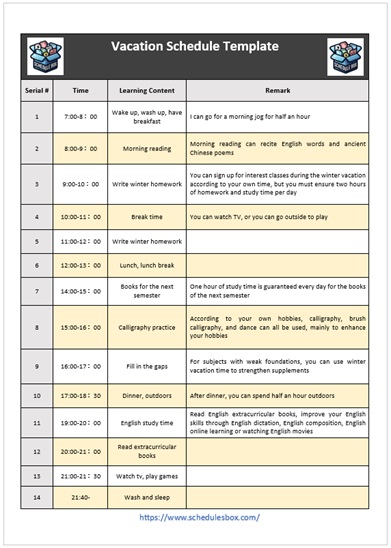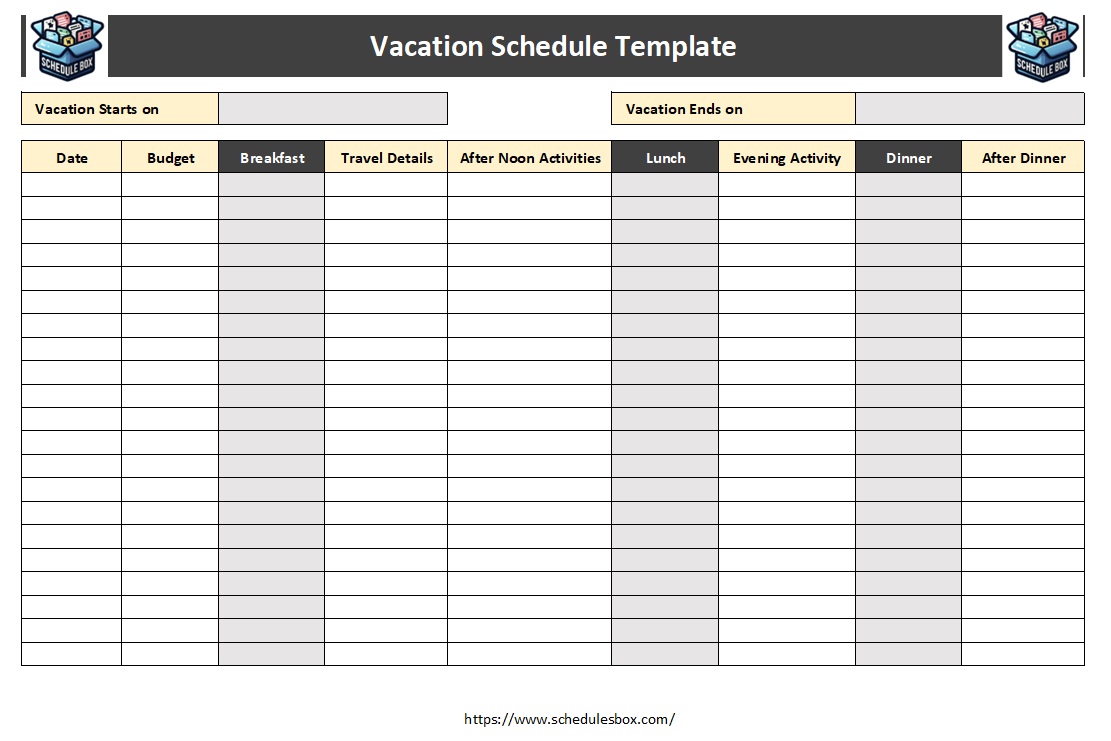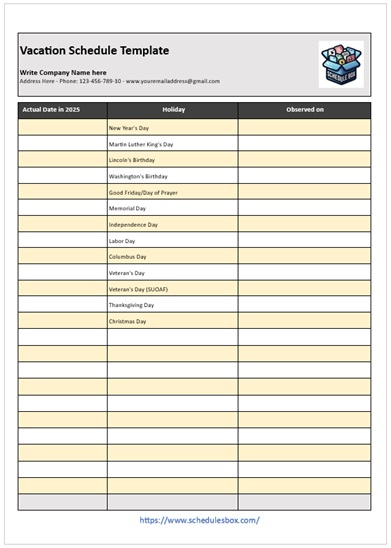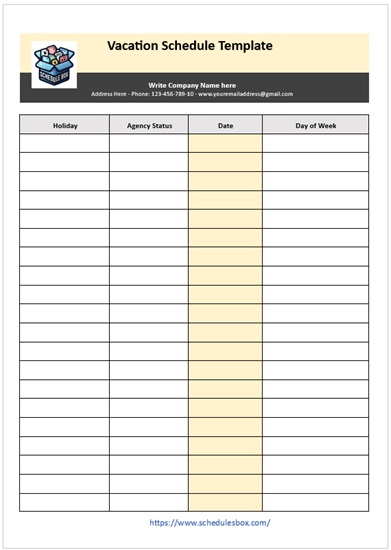Here are our Free Vacation Schedule Templates to help you plan your next Vacation Trip efficiently.
A Vacation Schedule is a timetable that shows when an employee can go on vacation during a given period which is mostly considered a year. This schedule is important because it helps in governing the absence of employees thus ensuring the smooth running of an organization. Here are some key aspects of a vacation schedule:
- Planning and Coordination: The process involves coordinating employees’ vacation requests so that all team roles are covered and business operational requirements are fulfilled. This frequently means reconciling employee interests with the imperatives of the organization.
- Fairness and Transparency: During the preferred periods, vacation schedules usually are developed effectively with a focus on fairness so that all staff can get time away from work equally even though some factors such as seniority or role criticality may be taken into account like previous vacation allocations.
- Clear Policies: Vacation time requests generally follow universally accepted principles in most organizations. These rules normally dictate that such requests should be made a certain number of days before the expected date of the vacation; they also specify what happens in case there is a conflict in scheduling. Such stands exist because approval for breaks is denied during peak periods or when there is heavy work-related pressure.
- Communication: It is crucial to keep everyone informed with regard to the vacation timetable. It should also be noted that the staff must be informed quickly about whether their leave approval will be granted or not and other adjustments in the program.
- Software and Tools: Numerous companies make use of scheduling software or human resource management systems to monitor and manage vacation requests, thereby making the process more efficient and transparent.
A properly managed vacation arrangement makes sure the business remains efficient by maintaining a manageable workload, and at the same time considers the personal time and good health of employees, making it a win-win situation.
Free Vacation Schedule Templates
Here is a collection of Free Vacation Schedule Templates that I have created using MS Word and MS Excel to assist my website visitors.
Types of Vacation Schedules
In view of their size, industry, or peculiar operational demands, there are different types of vacation schedules that organizations use. Here are some common types:
- Fixed Vacation Schedules:
- Set Periods: There are companies that halt work at different intervals during the year, for example, end-of-year holidays and factory maintenance holidays so that all employees go on leave at the same time.
- Rotating Schedules: Human employees in sectors such as healthcare and law enforcement that have rotational schedules could make the timing of their vacations, thereby guaranteeing that operational requirements are constantly fulfilled.
- Flexible Vacation Schedules:
- Floating Holidays: Employees decide on their holiday time, usually requiring them to ask for and receive approval on business necessities and co-worker’s vacations.
- Unlimited Vacation: A policy of unlimited vacation days off is great as long as employees adhere to the performance standards and agree with their team and supervisor.
- Earned Vacation Schedules:
- Accrual Systems: The number of hours worked or the period of service determines the amount of vacation time an employee earns. When they wish, approval permitting, they can take time off.
- Seniority-based Schedules:
- Priority Based on Tenure: In other organizations, people who have held their current jobs for a long are often given the first priority when applying for leave of absence, or they have more opportunities to change their planned holidays.
- First Come, First Served:
- Open Request Systems: Leave time will be granted on the principle of first come first serve where requests usually have to be made well in advance, especially during peak vacation times.
- Mandatory Vacation:
- Required Time Off: In certain job positions, such as a finance manager or an IT specialist working at a highly secure place the employees might be forced to take leave for several days in sequence so as to curb embezzlement and avoid over-reliance on any individual.
The choice is often the result of finding the right balance between organizational needs and employees’ preferences and welfare, as every schedule type offers benefits and challenges.
Benefits of using our Vacation Schedule Templates
Organizations looking to streamline the process of managing employee vacations will find ready-made vacation schedule templates very useful. Here are some of the main advantages:
- Time Efficiency: Rather than starting from scratch every time, templates save time as they provide predefined structures that can be easily filled out and adjusted by managers and HR personnel. Consequently, this simplifies the vacation schedule-making process, particularly for start-ups or small expanding companies.
- Consistency: Consistency in how vacation schedules are managed is ensured by using the same template in the organization. This ensures that vacation policies are applied fairly and misunderstandings are avoided.
- Ease of Use: In general, prefabricated templates are user-friendly as well as built using best practices. One of the most common features that can be found in these pre-made forms is that they have come up with some tips and sectors or parts for entering users’ data avoiding any possible mistakes (such as intuitiveness).
- Improved Planning: Meant to help organizations come up with better plans by showing graphically the individuals who are off-work and when these templates facilitate the identification of periods during which there could be personnel shortages or clashing holiday time-offs.
- Better Communication: When all employees use the identical form, it makes it easier to know when a colleague is on vacation and how it influences what one is doing at work.
- Integration with Other Tools: A lot of templates are created in such a way that they are in harmony with popular business-oriented software including Microsoft Excel, Google Sheets, or specific HR software, thus enabling them to be easily integrated into current business processes.
- Legal and Policy Compliance: Templates can be customized to sync with the regional labor laws as well as internal company policies on off-days. This facilitates compliance with the rules of the corporation while handling worker’s leisure days.
- Scalability: When companies expand, it becomes necessary for their systems to be able to tend to more complicated scheduling tasks. More elaborate schedules that might require the attendance of additional employees can also be addressed by altering the size and structure of templates.
Vacation schedule templates that are premade can reduce administrative burdens in organizations, enhance efficiency, and improve operational planning as well as employee satisfaction.









